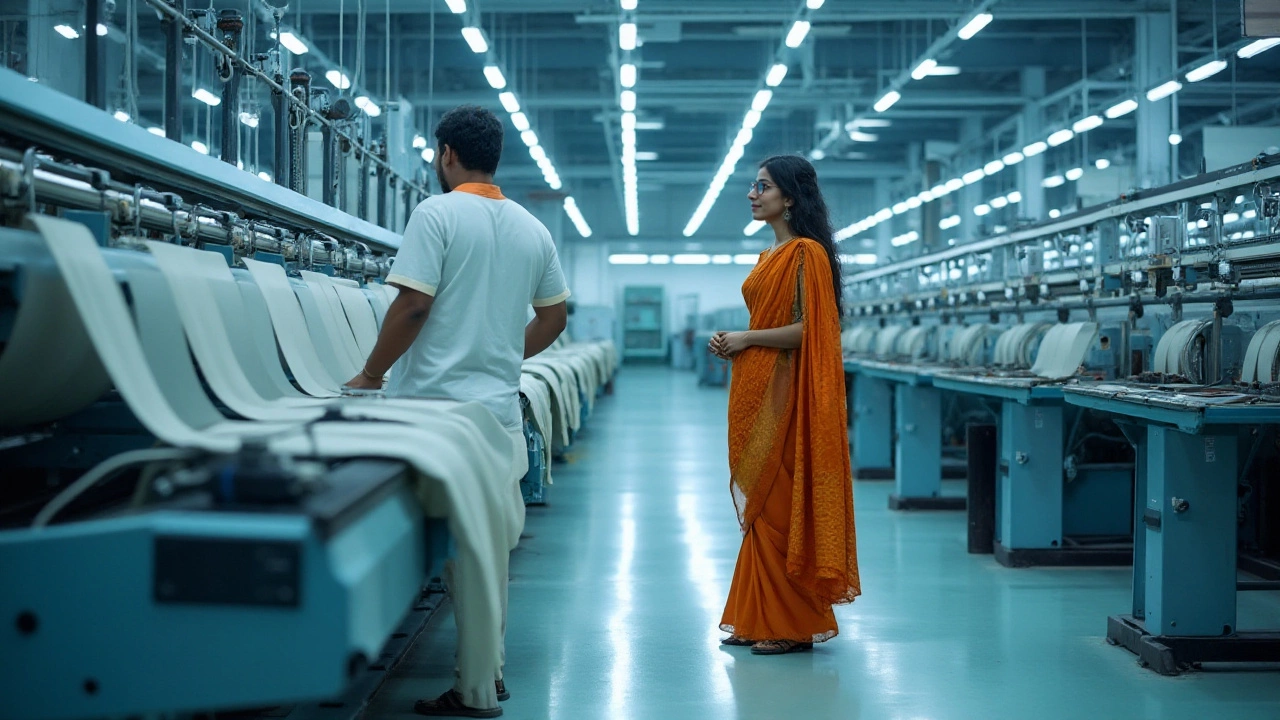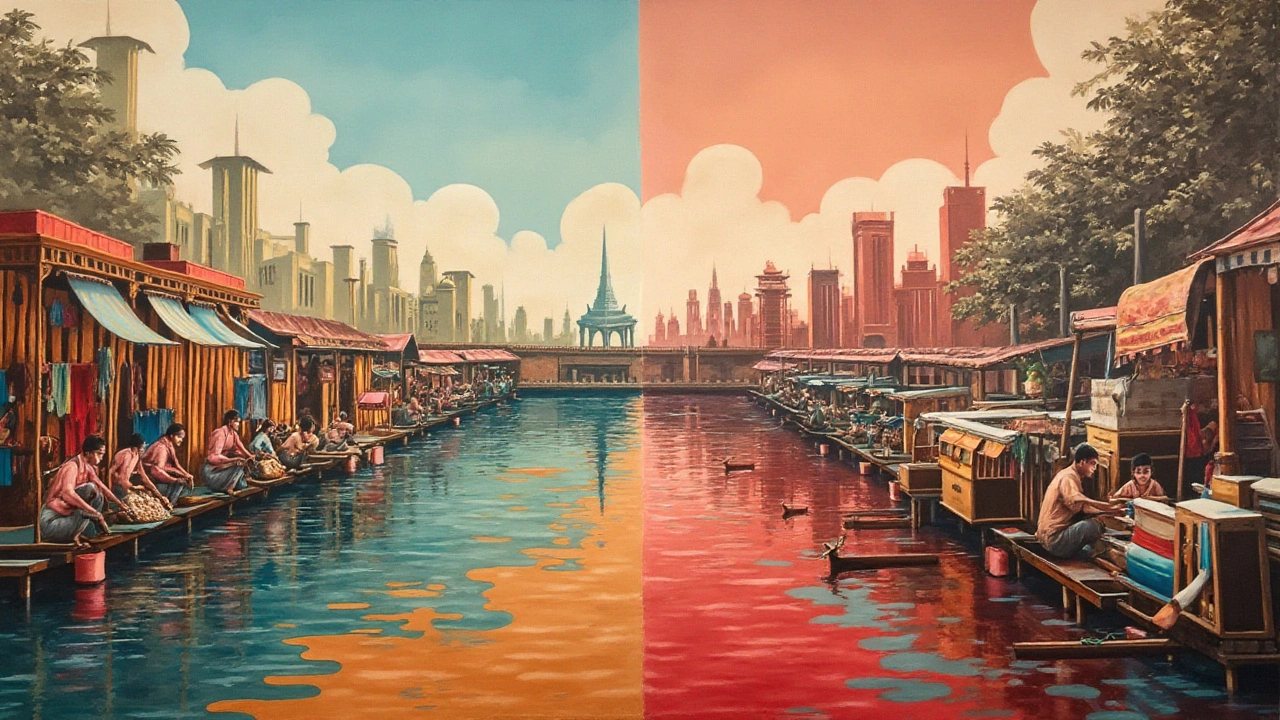Ahmedabad, a vibrant city in western India, has woven its name into the fabric of the nation as a prominent textile hub. Often referred to as the 'Manchester of India', this city is intertwined with the textile industry, playing a pivotal role in shaping its economic landscape.
The roots of Ahmedabad's textile prominence date back several centuries, with a boom during the British colonial era when it emerged as a key player in cotton production. With access to a steady supply of raw materials and the presence of many skilled artisans, the industry flourished.
Today, Ahmedabad continues to lead the textile sector by embracing modern technologies and sustainable practices, meeting the demands of both local and global markets. It stands as a testament to the enduring spirit and innovative capabilities of its people, maintaining a delicate balance between tradition and progress.
- Historical Overview of Ahmedabad's Textile Industry
- Major Textile Hubs and Players in Ahmedabad
- Technological Advancements and Innovations in Ahmedabad Textiles
- The Impact of Ahmedabad Textiles on the Global Market
- Sustainability and Future Prospects for Ahmedabad Textiles
Historical Overview of Ahmedabad's Textile Industry
Ahmedabad’s journey to becoming a textile city has deep roots, tracing back to the medieval period when it was a thriving commercial center strategically situated along major trade routes. The groundwork for its textile prowess, however, was truly laid during the 19th century. The city began to transform with the establishment of its first textile mill in 1861 by Ranchhodlal Chhotalal. This marked the dawn of what would become a booming textile industry landscape. The mill quickly gained recognition, thanks to Ahmedabad's abundant supply of raw cotton and access to the Sabarmati River, which provided the necessary water resources for the dyeing and processing of fabrics.
The true golden era for Ahmedabad textiles unfolded under British rule when it earned the moniker 'Manchester of India'. This comparison to the UK's textile capital was not merely hyperbolic. By the early 20th century, the city had over 51 mills, solidifying its position as the second-largest textile producer in the country. A significant influx of skilled labor and strategic investments in machinery from British firms helped boost production capabilities. The integration of power looms allowed Ahmedabad to expand rapidly, supplying fabrics far beyond India's borders.
Remarkably, the city's growth was also driven by its unique blend of entrepreneurship and community spirit. Industrialists such as Kasturbhai Lalbhai and Sarabhai families played crucial roles in setting up new mills and fostering an innovation-friendly environment. The Lalbhai family, in particular, laid down a legacy of philanthropy and commitment to sustainable growth that resonates within the community even today. Under their leadership, mills focused not just on economic gains but also on the welfare of workers, establishing educational institutions and healthcare facilities for their employees.
One significant figure in Ahmedabad’s textile narrative is Mahatma Gandhi, who advocated for the use of khadi as a tool for economic self-reliance during the Indian independence movement. His call for the handmade cloth not only resonated with nationalist sentiment but also aligned with Ahmedabad’s core textile capabilities. As Gandhi made his home at Sabarmati Ashram, the city became a fulcrum for the Swadeshi movement, emphasizing Indian-made goods and self-sufficiency.
The post-independence era witnessed significant transformations as well. With India becoming a free nation, Ahmedabad’s textile industry faced both challenges and opportunities. Global competition increased, yet the city adapted by diversifying into man-made fibers and modernizing its infrastructure. Resilient entrepreneurs invested in new technologies and processes, paving the way for Ahmedabad's textiles to remain competitive and relevant in a rapidly changing world.
Today, while the city has pivoted towards more diversified industries, its proud legacy as a textile titan continues to shine. Efforts to revive traditional weaves and integrate innovative practices into fabric manufacturing reflect an ongoing narrative of change and adaptation. As we reflect on this historical journey, it is clear that the threads of Ahmedabad's past continue to weave into its present, ensuring its place on the global textile stage.
“Ahmedabad's textile sector is not just an industry; it's a symbol of innovation, resilience, and cultural significance.” — Textiles Historian A.K. Ramesh
Major Textile Hubs and Players in Ahmedabad
Ahmedabad has become synonymous with textile innovation and prowess, hosting a myriad of industries that contribute significantly to India's fabric manufacturing landscape. Among these, the comprehensive influence of regions like Naroda and Odhav cannot be understated; these industrial areas house several textile mills and factories that have been operational for decades. From spinning mills to garment processing units, the infrastructure here is robust, catering to both national and international demands. Naroda Industrial Estate is particularly renowned for its textile manufacturers who specialize in producing high-quality cotton and denim fabrics, contributing substantially to the city's economy.
In tracing the city's textile journey, strategic players like Arvind Limited stand out. This world-renowned company has been an integral part of Ahmedabad's textile identity, revered for its pioneering work in the textile industry. Established in 1931, Arvind Limited has expanded its operations beyond traditional fabrics, venturing into high-tech fabrics and the ready-to-wear market. Another significant player, Reliance Industries Limited, operates extensive facilities in Ahmedabad, leveraging cutting-edge technology to maintain its competitive edge. The presence of such giants sustains a vibrant ecosystem where smaller vendors and artisans find opportunities to thrive.
The contribution of educational institutions like the National Institute of Design and the National Institute of Fashion Technology cannot be ignored. Their role in cultivating talent ensures a steady flow of creative professionals who invigorate the textile scene with contemporary designs while respecting traditional techniques. The synergy between these institutions and the industry is palpable, often leading to innovative collaborations that push boundaries. High-profile textile parks, like the Gujarat International Textile Park (GITP), demonstrate the state's commitment to enhancing this sector's capacity and scope. These parks provide a conducive environment for innovation, sustainable practices, and global trade partnerships.
"Ahmedabad's textile industry is the backbone of India’s fashion sector, not just for its scale but for its ability to constantly reinvent itself," stated Dr. Mukesh Patel, a leading industry analyst.
Aside from large corporate entities, the city thrives with a vibrant network of small-scale industries and handloom weavers. These grass-root operations are the heart of Ahmedabad's traditional textile sector, embodying the city's cultural ethos while adapting to the changing tides of fashion. They play a crucial role in crafting unique designs that appeal to niche markets, keeping the heritage alive. Amidst modern manufacturing parks, areas like Ratanpole offer a glimpse into the traditional market dynamics where local entrepreneurship flourishes. This blend of old and new defines the fabric of Ahmedabad's diverse textile scene.

Technological Advancements and Innovations in Ahmedabad Textiles
Ahmedabad has always been a city of innovation, particularly in its ever-evolving textile sector. In recent years, manufacturers in Ahmedabad have leveraged cutting-edge technology to enhance production efficiency, improve fabric quality, and even reduce environmental impact. This adaptation of technology has not only helped streamline operations but has also set a benchmark for other textile hubs across the nation. Automating spinning and weaving processes with state-of-the-art machinery allows for a seamless production line that significantly minimizes errors and maximizes yield.
One of the most revolutionary changes seen in the city's textile industry is the integration of digital printing technologies. Unlike traditional methods, digital printing offers flexibility, precision, and vibrant color possibilities, opening new avenues for creativity and customization. Textile manufacturers in Ahmedabad have embraced these advancements to cater to the dynamic demands of fashion-forward consumers both locally and globally. This innovation has indeed made Ahmedabad textiles synonymous with quality and style.
A recent industry report by the Indian Textile Journal highlights Ahmedabad's role in digital textile printing, stating, "Ahmedabad has become a powerhouse for digital textile printing in India, much due to its forward-thinking entrepreneurs and skilled workforce."
Another game-changer in the industry has been the incorporation of environmentally-friendly practices. Water-efficient dyeing technology is being adopted to conserve precious resources while ensuring vibrant and long-lasting colors. Conscious of its environmental footprint, the city has seen a shift towards sustainable practices, with many textile manufacturers investing in eco-friendly processes and recyclable materials. This not only helps protect the environment but also meets the increasing consumer demand for sustainable fashion options.
Moreover, the integration of smart technology into the textile production line has enhanced supply chain management, providing real-time data analytics that aids in decision-making and inventory control. This has proven instrumental in improving delivery times and reducing waste, making Ahmedabad textile industry one of the most responsive and agile in the nation. The commitment to innovation and sustainability is evident in every stage of the textile production process, establishing Ahmedabad as a leader in the arena of textile manufacturing.
These technological advancements place Ahmedabad at the forefront of the textile industry not just in India but on the global stage. The city's ability to harness innovation has undoubtedly solidified its reputation as a premier destination for textile manufacturing, where tradition meets forward-thinking production strategies. By continuously investing in next-gen technologies, Ahmedabad's textile manufacturers ensure their offerings remain competitive and relevant in an ever-evolving marketplace, thus securing a prosperous future for the entire industry.
The Impact of Ahmedabad Textiles on the Global Market
Ahmedabad has long been a cornerstone of India’s textile industry, earning a prominent place on the global map. This distinction stems from its rich history and adaptability, which has allowed the city to keep pace with changing trends in the textile industry. The city's exporters have built an extensive network across various continents, supplying quality materials that cater to both low-cost and high-end fashion industries. Its ability to produce an array of products, from traditional cotton fabrics to innovative synthetic textiles, makes Ahmedabad a versatile player in the global market.
The city's textile industry is driven by a mix of massive mills and smaller, craft-based factories. These establishments utilize cutting-edge technology while preserving traditional production methods. This combination ensures that Ahmedabad can offer unique, high-quality fabrics that are sought after globally. The demand for Ahmedabad textiles is particularly high in markets such as the United States, Europe, and beyond. Exports from Ahmedabad have contributed significantly to India's textile export economy, with some estimates suggesting that its textile sector accounts for around 10% of the country's total textile exports. This statistic highlights just how vital Ahmedabad is to India’s role in the global supply chain.
One factor that enhances Ahmedabad’s market position is its commitment to sustainable practices. Many manufacturers in the city have begun to implement eco-friendly production methods. For example, recycling materials and minimizing waste have become part of the standard practice in aiming to reduce the carbon footprint. As the global market increasingly favors environmentally sustainable products, Ahmedabad’s focus on sustainability provides it with a competitive edge. A reputed local manufacturer once stated,
"Our embrace of green technology not only helps the planet but also ensures our place in future markets."This forward-thinking approach aligns perfectly with international consumer trends.
In addition to sustainability, technological innovation drives the growth and global impact of Ahmedabad textile exports. The integration of advanced machinery and software solutions has streamlined processes and enhanced production capabilities. With these advancements, local producers can meet the specific demands of international clients and maintain high standards of quality. An interesting development is the use of smart textiles, which incorporate modern technology into fabrics, adding functionalities like UV protection and temperature regulation. These innovations generate excitement in the textile community and allow Ahmedabad to capture niche markets that value cutting-edge features.
The success of Ahmedabad in the global textile arena is no small feat, and it owes much to the relentless pursuit of excellence by its textile professionals. They understand the importance of nurturing relationships with clients worldwide, offering exceptional customer service, and consistently delivering on promises of quality and timeliness. As the city continues to adapt and grow, its impact on the textile industry globally is poised to expand further, cementing Ahmedabad's status as a powerhouse in fabric manufacturing. The buzz surrounding Ahmedabad textiles remains strong as it continues to influence trends and shape the future of the textile industry internationally.

Sustainability and Future Prospects for Ahmedabad Textiles
Ahmedabad's textile industry is increasingly embracing sustainability as a core tenet of its operations. With growing awareness about environmental impact, many manufacturers in the region are shifting towards eco-friendly practices. This green revolution is not just a trend but is seen as a necessary evolution to ensure the longevity and ethical grounding of the textile industry. Factories are adopting water-saving technologies, such as zero-liquid discharge systems, to significantly reduce water waste in processing. Plus, the integration of organic fibers, dyes, and fabrics marks a shift toward more environmentally responsible production methods.
Driven by both local demand and international pressure, many textile firms in Ahmedabad are investing heavily in reducing their carbon footprint. Solar energy is becoming a popular choice, replacing traditional and less sustainable forms of power. By harnessing the sunlight generously available in this part of India, companies are not only cutting costs but also contributing positively to the environment. The shift towards digitization with AI-driven tools is enhancing efficiency in production, leading to lesser wastage and lower emissions. This technological leap is integral to supporting sustainable practices and keeps the industry aligned with global standards.
The prospects for Ahmedabad textiles look promising, with the city poised to expand its reach in international markets. By delivering high-quality, sustainable products, Ahmedabad is capturing the attention of buyers who prioritize ethical sourcing. This is opening new avenues for trade, particularly in regions where eco-friendly production is highly valued. The fusion of traditional craftsmanship with modern techniques ensures that the city remains competitive and attractive to designers and retailers worldwide.
Education and training programs are also pivotal in this transformation, with institutes in Ahmedabad emphasizing sustainable manufacturing principles. By equipping the workforce with the skills needed to execute sustainable practices, the city ensures a consistent and quality output, ready to meet future demands. Opportunities in research and development are identified as critical areas for growth where innovation can lead to groundbreaking changes not just in textiles, but in the approach to manufacturing as a whole. Govind Patel, an industry expert, once noted,
"Our success lies in our ability to weave tradition with innovation, blending old-world charm with cutting-edge technology."
The challenges remain, such as adapting to continuously evolving regulations and ensuring supply chain transparency, but with the current trajectory, Ahmedabad seems well-prepared to tackle these obstacles. Businesses that embrace these changes are likely to thrive, setting a new benchmark for the textile industry in India. The city is steadily paving the path for a future where textiles are produced with integrity and a deep respect for the environment, ensuring Ahmedabad remains at the forefront of the global textile market.

